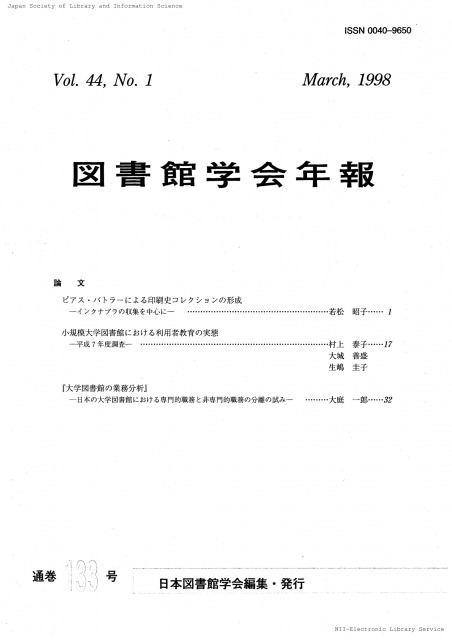All issues

Volume 37 (1991)
- Issue 4 Pages 153-
- Issue 3 Pages 103-
- Issue 2 Pages 49-
- Issue 1 Pages 1-
- Issue Supplement Page・・・
Volume 37, Issue 1
Displaying 1-4 of 4 articles from this issue
- |<
- <
- 1
- >
- >|
Article
-
Hiroshi KAWAIArticle type: Article
1991 Volume 37 Issue 1 Pages 1-9
Published: 1991
Released on J-STAGE: November 10, 2021
JOURNAL FREE ACCESSIn his young years Karl Preusker (1786-1871) worked at two book sellers. He was influenced by the liberal attitude of the enlightened shopkeeper. He was also impressed deeply by the books on popular education by Heinrich Stephani (German) and Henry Brougham (Englishman), and established the Grossenhain School Library in 1828, which was named City Library in 1833. The objectives of the library were: general and vocational education for the working adults and young people.
As in the 17th century the enlightenment inspired the self education of the people, Preusker intended to develop the education of the home industry workers and merchants. At this stage of the history of capitalism, however, these people were threatened to fall down to the proletarian workers, and in 1844 a violent uprising of these people broke out in Sachsen. The enlightenment had lost its initial nature, it meant rather the education of the lower class by the upper ruling class to maintain the present social system. The popular education by Preusker contributed much to the development of society in the same direction. Moreover the concept of “Humanitat” of Johann G. von Herder lead Preusker to the humanistic way of thinking of the Historicism, one of the reaction against the rationalistic enlightenment. His first public library, which was encouraged by the royal governments of Sachsen and Preussen, may be called the typical product of the reactionary years of German Restauration.View full abstractDownload PDF (1641K) -
Hirotoyo ISHIIArticle type: Article
1991 Volume 37 Issue 1 Pages 10-21
Published: 1991
Released on J-STAGE: November 10, 2021
JOURNAL FREE ACCESSA model for hit rate, which is one of the basic indicaters for the efficiency of online shared cataloging system (OSCS), was developed to reveal the factors affecting hit rate and characteristics of hit rate fluctuation.
At first, the basic elements which characterise OSCS were picked up through the analysis of OSCS served by National Center for Science Information System (NACSIS-CAT). Then, a OSCS model, in which the organisation of database and framework of cataloging operation through OSCS were defined, was developed. A state equation of hit rate was derived from the model. The equation is λ=1-(1-μ)/ρ, where λ is a hit rate, μ is a copy rate of bibliographic records (rate of copied records), and ρ is a ratio of number of holding to bibliographic records. Fluctuation of hit rate was demonstrated using the model and some applications of the model including application to the planning of retrospective conversion of catalog data, were suggested.View full abstractDownload PDF (1835K)
-
1991 Volume 37 Issue 1 Pages 22-43
Published: 1991
Released on J-STAGE: November 10, 2021
JOURNAL FREE ACCESSDownload PDF (3141K)
Summary
-
Article type: Summary
1991 Volume 37 Issue 1 Pages 47
Published: 1991
Released on J-STAGE: November 10, 2021
JOURNAL FREE ACCESSDownload PDF (471K)
- |<
- <
- 1
- >
- >|